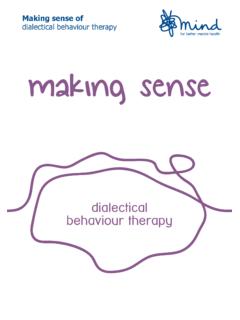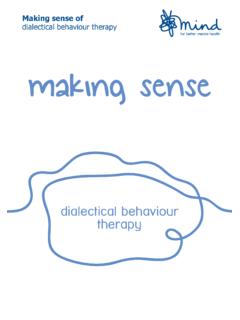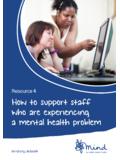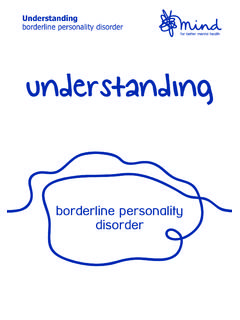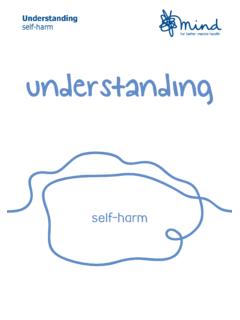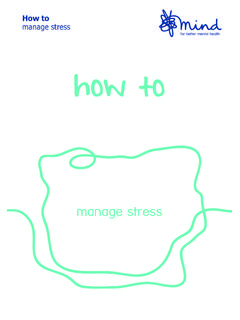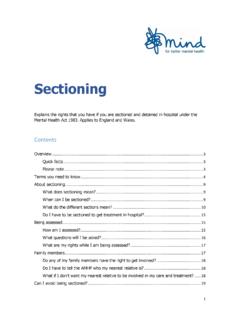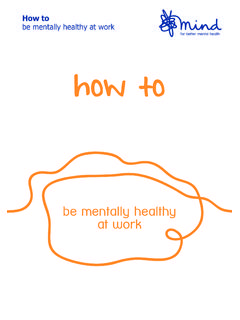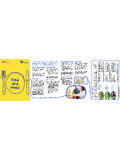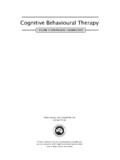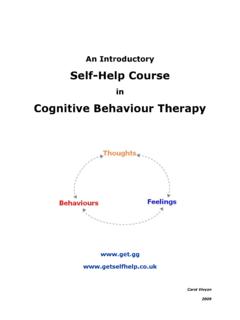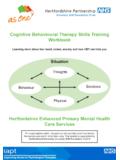Transcription of Cognitive behavioural therapy (CBT) - Mind
1 1 Cognitive behavioural therapy (CBT) This resource explains what Cognitive behavioural therapy (CBT) is, what it is for, what happens during therapy and how to find a therapist. Contents What is CBT? .. 2 What's the theory behind CBT? .. 2 How does CBT work? .. 3 What types of problems can CBT help with? .. 3 Does CBT work without medication? .. 4 What should I expect from a CBT session? .. 4 How is CBT delivered? .. 4 How are sessions structured? .. 5 What might I learn? .. 5 What s the therapeutic relationship like? .. 5 Is CBT right for me? .. 6 How can I find a CBT therapist? .. 7 Useful contacts .. 8 2 What is CBT? CBT is a type of talking treatment that focuses on how your thoughts, beliefs and attitudes affect your feelings and behaviour, and teaches you coping skills for dealing with different problems. It combines Cognitive therapy (examining the things you think) and behaviour therapy (examining the things you do).
2 I have depression. [CBT is] very, very good for helping [me] not listen to [my] self critical voice, which is so damaging. What's the theory behind CBT? CBT is based on the idea that the way we think about situations can affect the way we feel and behave. For example, if you interpret a situation negatively then you might experience negative emotions as a result, and those bad feelings might then lead you to behave in a certain way. How does negative thinking start? Negative thinking patterns can start from childhood onwards. For example, if you didn't receive much attention or praise from your parents or teachers at school, you might've thought "I'm useless, I'm not good enough". Over time you might come to believe these assumptions, until as an adult these negative thoughts become automatic. This way of thinking might then affect how you feel at work, university or in your general life.
3 If your negative interpretation of situations goes unchallenged, then these patterns in your thoughts, feelings and behaviour can become part of a continuous cycle: 3 How does CBT work? In CBT you work with a therapist to identify and challenge any negative thinking patterns and behaviour which may be causing you difficulties. In turn this can change the way you feel about situations, and enable you to change your behaviour in future. You and your therapist might focus on what is going on in your life right now, but you might also look at your past, and think about how your past experiences impact the way you see the world. CBT is learning to stop the cycle of negative thinking. I still have relapses now and it is the one tool that I use to get me out of the truly dark spots. What types of problems can CBT help with? CBT is a relatively flexible therapy that can be adapted to meet your particular needs.
4 Evidence suggests it can be an effective treatment for a range of mental health problems, such as: anxiety and panic attacks bipolar disorder borderline personality disorder depression eating problems obsessive-compulsive disorder (OCD) phobias post-traumatic stress disorder (PTSD) psychosis schizophrenia The National Institute for Health and Care Excellence (NICE) particularly recommends CBT for depression and anxiety. There are also formal adaptations of CBT to treat particular mental health problems, such as phobias, eating disorders, PTSD and OCD. You may also be offered CBT for: anger problems drug or alcohol problems sexual and relationship problems insomnia (inability to sleep) CBT got me through my chronic health anxiety disorder. It was a tough six months, but I still use the skills I learnt over 10 years ago to rationalise with myself. CBT can also help you find new ways to cope with physical health problems, such as: chronic fatigue syndrome chronic pain habits or problems, such as facial tics general health problems You may also be offered CBT if you are experiencing a mental health problem alongside a physical health problem.
5 The tools and techniques you learn during CBT can often be applied to other problems in the future. 4 Does CBT work without medication? For some people CBT can work just as well as medication for treating problems like depression and anxiety disorders. Depending on the symptoms you experience, your doctor might suggest that a combination of CBT and medication, such as an antidepressant, might be more effective for you. If you want to discuss whether CBT is the right treatment for you, you can talk to your GP (also see our page on is CBT for me? and having your say in treatment). I had when I had severe depression. It got me through a really tough time, from being suicidal and off work on long term sick [leave], to fully functioning again and now in a successful career. I found it worked really well in combination with antidepressants. It pulled me back from a very dark place and reintroduced structure to my life when I'd given up.
6 What should I expect from a CBT session? In this section you can find information about: how is CBT delivered? how are sessions structured? whatmight I learn? What s the therapeutic relationship like? Can I do CBT by myself? How is CBT delivered? CBT is usually a short-term treatment, so you wouldn't be expected to continue with the treatment for a long time. For example, a course of CBT might be delivered in 12 hour-long weekly sessions, spread across 12 weeks. In some areas, you may be offered four sessions initially, with the opportunity for more if you need them. These sessions might be delivered: individually one to one with a therapist (either face-to-face, over the phone or over a video call) in a group with other people who may have similar problems through a self-help book you might be asked to complete exercises from a book by yourself through a computer (usually online) you may be offered computerised CBT.
7 CBT should only be delivered by a trained health care professional. Refresher CBT programmes may be available if you have already completed a course of CBT (your GP may know more about options in your area). Computerised CBT There are some interactive online CBT programmes, for example Beating the Blues for depression , and FearFighter for panic, anxiety and phobias. If you want to use Beating the Blues or FearFighter for free, you will need a referral from your GP or other 5 service-provider. Some online CBT programmes include phone or email contact with a therapist assigned to you. It can be difficult to decide what online programme is right for you. It s best to try and use one that has been recommended by your GP or another health professional. If you re finding it hard to stick to or complete a computerised CBT course, talk to your GP about other options. How are sessions structured?
8 A typical structure of a CBT session may include the following: At the beginning of the therapy , you and your therapist may explore the problems you want to work on. When you have agreed which problems you want to focus on and what your goals are, you may start planning the content of sessions and talking about how you could deal with your problems. During the session, you might work through exercises with your therapist to explore your thoughts, feelings and behaviours. This may be in the form of diagrams or worksheets. With CBT you are often given work to do in your own time, so the end of each session you might agree on some exercises to work on afterwards. At the beginning of your next session your therapist might start by going over the conclusions from your previous session, and discussing what progress you've made with any work you agreed to do. My therapist gives me goals that I must achieve before the next session.
9 They are challenging, yet achievable. What might I learn? CBT teaches coping skills for dealing with different problems. You may learn ways of coping with different situations, thoughts, feelings and behaviours. For example: Problem Way of coping Feeling anxious You may learn that avoiding situations could actually increase fears. Confronting fears in a gradual and manageable way can give you faith in your own ability to cope. Feeling depressed You may be encouraged to record your thoughts and explore how you can look at them differently. This may help to break the downward spiral of your mood. Sleep problems You may learn to recognise the thoughts which make falling to sleep more difficult and learn to challenge these. Long standing problems relating to other people You may learn to check out your assumptions about other people's motivation for doing things, rather than often assuming the worst.
10 It can be daunting when faced with a list of things you can't do, but CBT helped me to break up my goals into manageable chunks. What s the therapeutic relationship like? 6 One to one CBT can bring you into a kind of relationship you may not have had before. CBT favours an equal, non-judgemental relationship between you and your therapist. They should seek your views and reactions to your experiences, which then shape the way your therapy progresses. The collaborative style means that you are actively involved in the therapy . This therapeutic relationship may help you feel able to open up and talk about things that are difficult or personal to you. I was encouraged to try [CBT] again with a different therapist and have just had my 3rd session. I like the therapist and am getting on much therapist makes a BIG difference! Can I do CBT by myself? It is possible to do CBT by yourself, through a self-help book or online.
